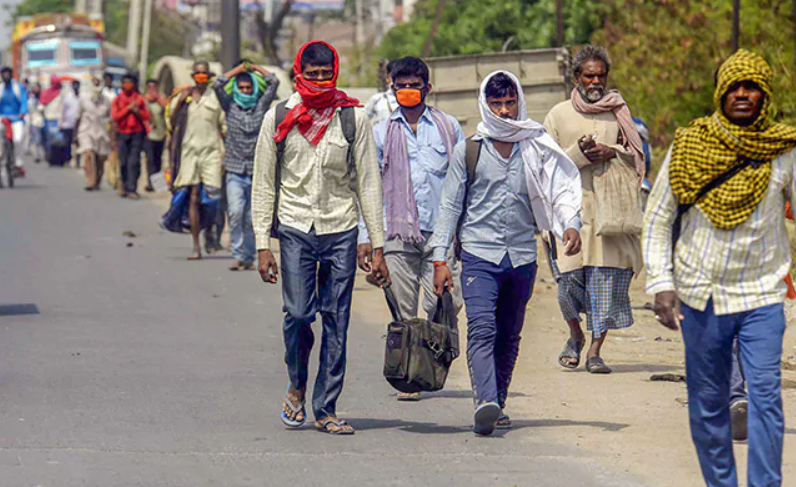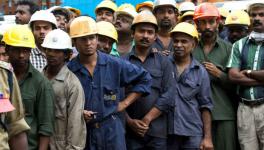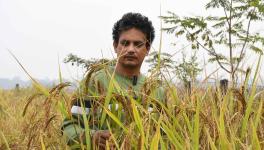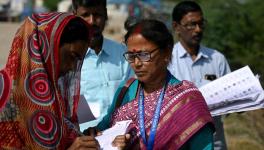CITU Launches Migrant Workers' Union in Bengal; Centre Commissions Survey for Migrants

Kolkata: Conceptualised about a year ago by the Centre for Indian Trade Unions (CITU), the West Bengal Migrant Workers' Union (WBMWU) has launched a membership drive in recent months. So far, the union says it has enrolled more than 40,000 members and issued identity cards to them.
West Bengal is the second state where the labour arm of the Communist Party of India (Marxist) is executing its plan to have a union exclusively for migrant workers. They planned it as the migrant workers across the country had a traumatic experience while returning from their workplaces in different states to their native places amid the hastily imposed national lockdown because of the Covid-19 outbreak last year. The CITU floated the first migrant workers' union in Karnataka in 2020. It has kept in view some other states where conditions are conducive for launching the union.
The partial lockdown in the state has impeded the membership drive, but it has partly helped the organisers because many of the returned migrant workers have not yet gone back to their places of work. The current tally of over 40,000 members may be ascribed to this situation.
The president of the WBMWU, Shaikh Mohammed Sadi, told Newsclick that their long-term plan considers the three categories of migrant workers. The three types include those who go to other states from West Bengal, those who come to West Bengal from other states and those who go abroad, particularly to the Gulf region, from the state.
"It's a long haul, a gigantic task, and we have our limitations. Therefore, we are emphasising the first category, which accounts for the largest chunk of migrant workers. Along with member enrolment, we are working out arrangements with our unions in the destination states to ensure that joint efforts to alleviate workers' sufferings in times of distress," Sadi said.
Without a worthwhile database, it is tough to put a reliable number to all three categories of migrant workers. "What we have are guesstimates. But we believe the total number may be around 50 lakh. The published figures suggest that 1.4 crore migrant workers came back to their home states, of which West Bengal's share was 13 lakh plus. We believe the real figures to be very much on the high side. West Bengal is the fourth most populous state in the country, and high out-migration states, such as Bihar, Odisha, and Jharkhand, surround it," the WBMWU chief said.
General secretary of the union, Abdul Mannan told Newsclick that they were initially chasing a membership target of five lakh, and the consensus was that the membership fee should be at least Rs 20 per year. The persisting restrictions on the functioning of offices have resulted in a delay in the registration process. Still, he said, "We are confident that after our interaction, the registration process, which involves hearings, will be through with the restoration of the normal functioning of offices."
The union is working on the joint effort concept to see that the migrant workers are treated properly both by their destination and home states. New Delhi's post-lockdown action plan did not factor in migrant workers, which was a "shameful example of exclusion," Mannan observed.
The West Bengal administration was initially reluctant to accept responsibility for the migrant workers returning home during the rise of the first wave of Covid-19. Chief Minister Mamata Banerjee had even reportedly described the long-distance trains bound for Howrah as 'Corona Express' (a remark she later denied having made). Meanwhile, the Odisha government had opted for a more humane approach.
Migrant Workers in Odisha Cautious
The Odisha authorities had launched a web portal to allow the stranded migrant workers, who were keen on returning to the state, to register themselves on the portal. Each of those registering was assigned a unique number. According to the co-convener of Odisha Khadya Adhikar Abhijan (OKAA), Sameet Panda, nearly 10 lakh people were registered on the portal. However, Panda added while speaking to NewsClick that this registration data did not reflect the reality of the reverse migration; in their assessment, the migrant workers from Odisha would easily exceed 20 lakh.
Panda contended that what was tragic and where the state administration found itself helpless was that many workers, who failed to get subsidised ration, had no money left to buy cereals and vegetables and, therefore, had to go without food some days. Such a condition arose as some employers failed to pay wages to the workers, and some employers made part payments. This forced the workers to remain where they were working, including in New Delhi and several towns in Tamil Nadu, Karnataka and Telangana, where garment units had hired them.
Subsequently, many migrant workers managed to return to their native places as Covid-19 cases dropped with the vaccination campaign gathering momentum. Now, even as the second wave recedes, will all the returnees go back to where they were working? "Doubtful," said the OKAA co-convener, "As they are still unable to live down their traumatic experience." However, he added that the workers were trying to get information about the condition prevailing at those factory locations.
Addressing how the situation was like after the first two waves of Covid-19, Prof Amitav Kundu told Newsclick that there had been a positive development as well as some adverse side-effects. Prof Kundu, a Senior Fellow at the New Delhi-sponsored independent think-tank Research and Information System for Developing Countries, said the positive development was commissioning a survey in January covering four unorganised sector segments. The segments include domestic workers, migrant workers, transport workers and informal workers engaged by accountants.
For the survey, preliminary work has begun, and several thousand enumerators are to be involved. The Union Labour & Employment Ministry has appointed the chairman of the board of governors of the Indian Statistical Institute as the chairman of the survey and Prof Kundu as the co-chairman.
Correcting The Lack of Migrant Data
The extreme suffering of lakhs of migrants workers during the national lockdown in 2020 when they left their work states in panic to be with their loved ones in villages and district towns showed that the government was not equipped to deal with the tragedy. One of the reasons behind this governance failure is the absence of reference-worthy statistics for migrant labour.
The exercises of the National Sample Survey Office (NSSO), which were referred to by the authorities, were not of much help as there was no district-wise segmentation of data. Census 2011, which had district-wise information, was not considered by them because the districts have been reorganised many times. The administration carved out new districts for genuine governance reasons and at times on "political considerations".
The situation, perhaps, would not have been as dire if the Inter-State Workmen (Regulation of Employment and Conditions of Service) Act, 1979 had been acted upon by the Centre and the states and amendments to the Act made as the situation evolved and the circumstances warranted.
The adverse side-effects stemmed from a vast number of migrant labour returning to their states of origin or places of the last residence. Contending that the number of unemployed people had soared, the states of origin have curbed the appointment of outsiders for specific categories of jobs. They insisted on engaging locals, but some states have also stipulated knowledge of the local language as a pre-requisite for employment. In reality, such moves are equivalent to an assault on India's federal character, Prof Kundu observed.
The second side-effect surfaced when the returnees sought opportunities under the rural employment guarantee scheme. The resident villagers apprehended a shrinkage of their scope for earning and, therefore, tried to resist the returnees' engagement. This gave rise to tension in many places. The matters normalised after the Centre pumped in more funds, he said.
Meanwhile, according to a report in The Economic Times edition of July 16, 2021, there was a staggering 50% fall in Bihar's remittances as many migrant workers left the places where they were earning their livelihood following the outbreak of Covid-19. This was one of the findings of a study conducted between October 2020 and January 2021 by researchers at the New Delhi-based Institute for Human Development and Australia's Monash University. The abrupt drop in remittances resulted from the loss of workdays that nine out of 10 workers had to suffer. The study was carried out across 1,613 households in 12 villages.
After the initial crisis, the Tamil Nadu government has decided to create a digital databank of migrant workers employed in industries, particularly in the MSME and hospitality sectors, according to a report in The Hindu edition of July 26, 2021, which quoted the state's industry minister Thangam Thennarasu.
Get the latest reports & analysis with people's perspective on Protests, movements & deep analytical videos, discussions of the current affairs in your Telegram app. Subscribe to NewsClick's Telegram channel & get Real-Time updates on stories, as they get published on our website.























